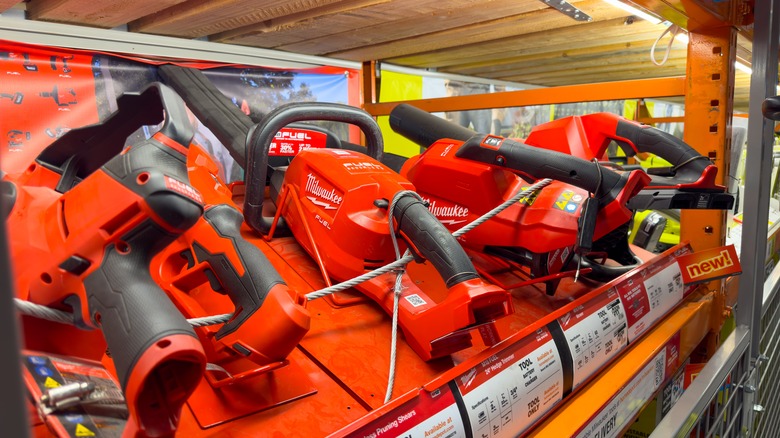
The Image Party/Shutterstock
Keeping your yard clean can be a real chore, whether you’re gathering leaves in autumn, clearing snow in winter, tidying your garden in spring, or cleaning up after construction projects in summer. You can always bust out a rake and gather your yard debris manually, but you can do it a lot faster and easier if you want to invest in some power tools.
Advertisement
Milwaukee has a couple of different products on offer that you can use to clean up your grass. The most obvious solution is to pick up the company’s M18 Fuel Blower tool. Leafblowers are a tried and true method for gathering up the fallen leaves, sticks, and other particulate that gathers on your lawn in the later parts of the year. It isn’t the only option, however. The company also manufactures an M18 Fuel Quik-Lok Rubber Broom Attachment, which people on power tool forums have affectionately taken to calling the Milwaukee Power Broom.
It’s easy to see why any home landscaper would want these Milwaukee tools, but you might be wondering which of them is better suited to your needs if you’re looking at getting one of these products to clean up your own yard. They’re both designed to pile up scattered yard waste, but it’s worth taking a look at the specific types of tasks each of them excels at so that you can have a better idea of which one will work better for your needs.
Advertisement
Use the leaf blower for light surface debris
The Milwaukee M18 Fuel Blower is a powerful cordless tool that promises to clear debris from 15 feet away. Its Powerstate brushless motor is powered by one of the company’s Redlithium High Output XC8.0 batteries. Because of this, the tool can push 450 CFM of air at a max speed of 120 MPH. This output is on par with similar offerings from DeWalt and Makita, and it’s a big part of the reason the blower is counted among Milwaukee’s top-rated tools. On top of that, the Blower has a variable speed trigger, high and low settings for speed control, and a lock button to help relieve fatigue.
Advertisement
This makes it great for moving and gathering copious amounts of light debris, such as dry leaves and twigs, grass clippings, loose dirt, or sawdust. Those who get light, fluffy snowfalls can even use it as a makeshift snowblower in the winter. It’s a lightweight tool, coming in at just 4.9 lbs., that you can use to move debris without having to strain yourself physically pushing it. The lower speed settings also allow you to clear more delicate areas, such as flower beds, that might otherwise be damaged by a more invasive tool. Some people might find that they struggle with wet leaves and other heavier debris, however, and that’s when you might be better off with the Power Broom.
Use the Power Broom for heavy or wet debris
The Milwaukee Rubber Broom Attachment is part of the company’s Quik-Lok Attachment System. Those who purchase the M18 Fuel Outdoor Power Head will be able to use several different attachments, such as a hedge trimmer, pole saw, edger, and string trimmer, all using the same power base. This is an all-in-one solution that’s designed to allow you to spend less on each tool while also saving storage space.
Advertisement
The rubber broom attachment is a basic rotary tool that uses rubber paddles to sweep anything it makes contact with. It has a 23″ clearing width and a shield to make sure you don’t accidentally launch the debris you’re trying to clear back at yourself. According to the product description, «The rubber broom attachment also features optimized gearing to manage the cordless M18 Fuel Power Head RPM output specifically for this attachment.»
While the blower is good for lighter materials, the Power Broom is rated to clear heavier debris like mulch and gravel. This makes it a better solution for wet leaves and packed snow that a blower simply wouldn’t be able to move. That said, using it requires a bit more effort on the part of the operator. Several user reports have claimed that pushing the broom attachment can be quite tiring when using it on bigger jobs. This makes sense, given that the 16.2 lb. tool weighs more than three times as much as the blower and requires more labor on the part of the user.
Advertisement